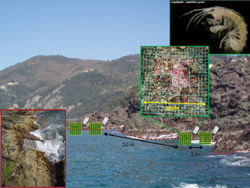Rocky shore biodiversity
A detailed understanding of the mechanisms behind changes in an ecosystem's biodiversity remains one of ecology's greatest challenges, but is crucial to successful coastal management and conservation. The EU-funded project 'Biodiversity and connectivity in the resilience of coastal marine communities' (Bioconnectence) has studied the ability of bottom-dwelling marine organisms along the intertidal zone of a rocky coastline to recover from disturbances. The intertidal zone is the area exposed to the air at low tide but at high tide is underwater. Researchers carried out a biodiversity survey of this zone along the Ligurian coast. Biodiversity can be described as the number and variety of animal and plant species within a region. The scientists also performed experiments across a number of sites to assess the role of ecosystems in influencing recovery rates, thereby assessing resilience. A major review of ecological resilience was also undertaken in an attempt to marry the current differences between theory and practical research in the field and laboratory. The project's findings have provided important data on environmental conditions as well as the abundance and diversity of rocky shore plants and animals. Project partners also collected data on little studied organisms, such as shrimp-like amphipods and syllid and nereid polychaete worms, which live among small 'turf' algae. These samples required painstaking identification and counting in the laboratory. Algal turf dwelling fauna have contributed to increased estimates of species richness along rocky shores, compared to traditional visual sampling techniques. Bioconnectence's sampling strategy enabled patterns to be identified over a range of spatial scales, thereby gaining greater information on the spatial scale of biodiversity change along the coast. Recognition of the importance of turf dwelling organisms in terms of biodiversity has encouraged fresh studies into the utilisation of primary food resources and overall food web structures. A food web is a community of organisms made up of several interrelated food chains. Scientists are particularly interested in the importance of detritus generated within the turf habitat. Data from the Bioconnectence project will help policy-makers, scientists and conservationists improve coastal management and particularly designated 'Marine protected areas' and their role in preserving biodiversity.



